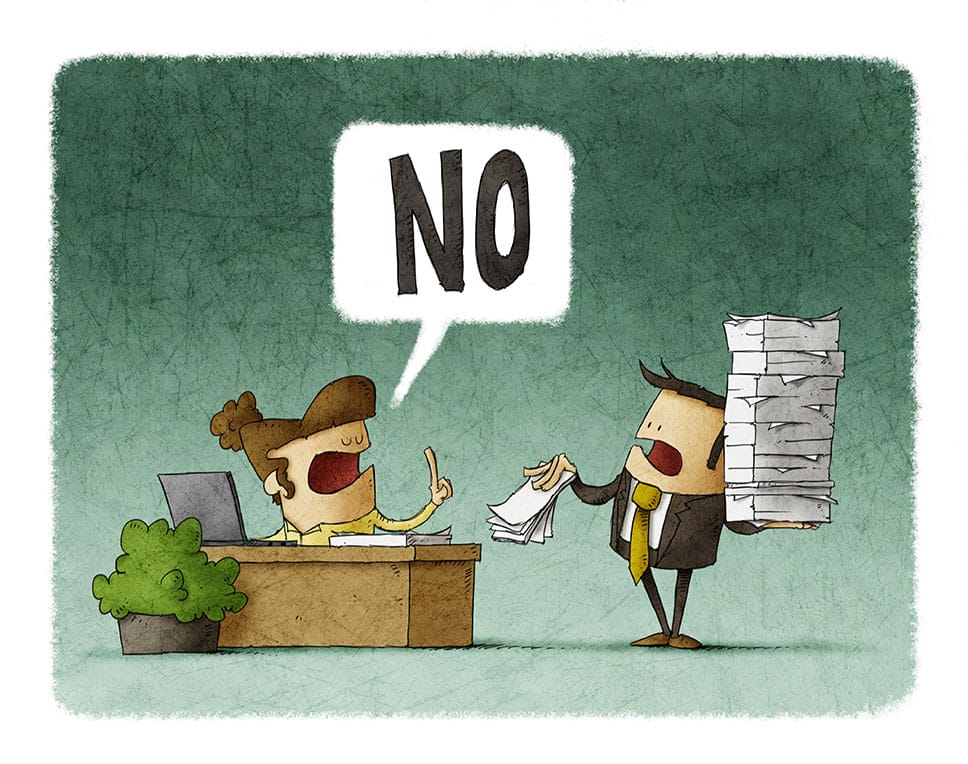How to Say No Professionally: Best Tips & Examples

Knowing how to say no professionally can protect your productivity and well-being, while maintaining positive relationships at work. This blog post offers practical tips and real-life examples to help you decline requests gracefully.
Key Takeaways
Saying no helps prevent burnout and maintains productivity by allowing you to focus on what truly matters.
Recognizing your workload capacity and trusting your gut feeling when declining requests are key to maintaining professional relationships.
Using polite phrases and offering alternative solutions when saying no can help keep doors open for future opportunities.
Why It’s Crucial to Say No Professionally


Constantly saying yes to every request might seem like the path to being a true team player, but it can also cause resentment and burnout, especially for those with a people pleaser or “yes person” outlook. Overloading yourself with tasks can undermine your job satisfaction and performance, making it difficult to meet your commitments effectively. Comparing yourself to other team members can exacerbate this issue, as everyone has different capacities and workloads. Saying no can change that. It can help you maintain mental health and productivity, allowing you to focus on jobs that truly matter. This, in turn, enhances your reliability and helps create a more organized work environment.
Demonstrating the ability to say no can actually improve the trajectory of your career. It represents strong communication skills and your skill at establishing boundaries that create a more positive and efficient workplace for everyone. Understanding the importance of declining requests protects your well-being and contributes to a healthier, more productive professional environment.
Recognizing When to Say No
Identifying the right moments to say no is crucial for maintaining a healthy work-life balance and professional relationships. If you’re overwhelmed by struggling with your workload, it’s a clear sign that you need to start declining more often. This helps prevent burnout and keeps your focus on essential tasks, boosting your productivity.
It’s also important to align new opportunities with your goals, be that short term or long-term, to avoid unnecessary stress. If a task or project doesn’t align with your work or long-term objectives, it usually means it’s not a priority for you. Additionally, if you start to feel uncomfortable, resentment or anger toward additional requests, it’s time to reassess and start saying no more frequently.
It’s important to recognize your workload capacity before accepting new tasks. This ensures that you don’t overcommit and can deliver on your existing responsibilities effectively. Being mindful of these indicators helps you make informed decisions about accepting or declining requests, maintaining both productivity and well-being.
Effective Tips for Saying No Politely


Mastering the art of saying no politely involves several strategies. From assessing your workload to offering alternative solutions, these tips will help you decline requests with grace and professionalism.
Let’s delve into each of these strategies in detail.
Assess Your Current Workload
Understanding your present workload is the first step in assessing your ability to take on new commitments. Using tools like a to do list can help you evaluate your workload effectively. Consider deadlines, the importance of the opportunity, and your specific job responsibilities when assessing a new request. This evaluation helps you avoid overwhelming yourself, thereby maintaining productivity in your existing responsibilities.
Before taking on new projects, carefully consider each extra project and its effects when there’s already too much on your plate. It could align well with similar tasks you’re working on, resulting in a better solution that meets long term goals and reduces stress overall. On the other hand, it might result in more work and extra time that has little to do with your other projects, creating extra stress in the long run. Taking on the wrong assignment really does matter.
Keeping a clear picture of your workload allows you to make informed decisions about accepting additional tasks. This not only helps you manage your time better but also ensures that you can deliver quality work on your current projects without overextending yourself.
Communicate Clearly and Directly
Clarity in your refusal minimizes the chances of miscommunications and potential conflicts. Being straightforward and honest when declining requests helps prevent misunderstandings and maintains your credibility. Avoid ambiguity and sugarcoating to ensure your message is clear.
When colleagues push back after you’ve said no, be firm yet polite, and reiterate your reasons for declining. You shouldn’t feel obligated to give excuses when saying no; maintain your stance clearly. Lying or being dishonest can erode trust and damage professional relationships.
Clearly communicating your limitations ensures your peers understand and respect your decision.
Lead with Positivity
Starting the conversation with a positive sentiment shows appreciation and builds rapport. For instance, you could begin with something like, “I appreciate you thinking of me for this opportunity,” before moving into your refusal. This approach softens the impact of your no and helps maintain a positive note relationship.
Provide a Brief Explanation
Giving a short and succinct explanation when saying no is vital to inform the person of your unavailability without inviting further negotiation. This helps colleagues understand your decision and maintains a positive relationship. A concise explanation, such as “I’m currently focused on other priorities,” is often sufficient.
Apologizing while explaining your schedule is an effective approach to decline professionally. An example could be, “I apologize, but at the moment I’m swamped with other tasks that require my immediate attention.” Keep your refusal simple to avoid giving an opening for negotiation.
Offer Alternative Solutions
Suggesting alternatives can alleviate the discomfort of saying no and maintains professional relationships. For instance, you could delegate the task to another qualified colleague or suggest alternatives for a different time for the request. This shows your willingness to support your teammates while setting boundaries.
Always aim to keep the door open for future collaborations, as this approach fosters a positive and cooperative work environment. For instance, you could say, “I can’t take this on right now, but I can assist with a similar project in the future.”
Practice Saying No
Practicing saying no builds confidence and helps improve communication skills. By rehearsing refusals in advance, you’re better prepared for unexpected requests and can respond more effectively. Having a set of prepared phrases can boost your confidence when needing to decline requests professionally.
Effective practice leads to better communication and more assertive responses in professional settings. Consider role-playing scenarios with a trusted colleague to refine your approach and ensure you’re comfortable with your refusals.
Best Practices for Saying No


Saying no at work can be challenging, but it’s essential for maintaining a healthy work-life balance, prioritizing tasks, and delivering high-quality results. Here are some best practices for saying no:
Be Clear and Direct: When saying no, be straightforward and avoid beating around the bush. Use a simple and concise phrase, such as “I appreciate the request, but I won’t be able to take on this task.” This approach ensures your message is understood without ambiguity.
Provide a Brief Explanation: Offer an explanation for why you’re saying no, but avoid making excuses or justifying your decision. A concise reason, like “I’m currently focused on other priorities,” can help the other person understand your perspective.
Suggest Alternatives: If possible, suggest alternative solutions or approaches that can help the other person achieve their goals. For instance, you might say, “This is a great opportunity but I can’t take this on right now. Perhaps [other team member] can assist.”
Set Boundaries: Establish clear boundaries and convey your priorities to your peers and boss to prevent overcommitment and ensure that you’re focusing on high-impact activities. For example, you could respond, “I need to focus on my current workload to ensure quality results.”
Practice Empathy: Saying no can be difficult for the other person and make them feel bad, so be empathetic and understanding. Acknowledge their request and show appreciation for their consideration. You might say, “This sounds interesting and I appreciate you thinking of me.”
Use Positive Language: Frame your no in a positive way by using phrases like “I’m honored by the request, but I won’t be able to take on this task.” This can help soften the blow and maintain a good relationship.
Be Consistent: Consistency is a key when saying no. Stick to your decision and avoid going back and forth. For instance, if you’ve declined a task due to your workload, remain firm in your decision to avoid confusion.
By following these best practices, you can say no at work without damaging relationships or feeling guilty. Remember that saying no is not a sign of weakness, but rather a sign of strength and prioritization.
How to Say No to Different People at Work


Saying no at work can vary depending on who is making the request. Whether it’s your boss, a coworker, or a client, each situation requires a tailored approach to maintain professionalism and positive relationships.
Let’s explore how to handle these different scenarios.
Declining Requests from Your Boss
It’s beneficial to remind your boss that they may not be fully aware of your workload. Highlighting your priorities at the moment and suggesting revisiting the request later can be a respectful way to decline new tasks. For example, you might say, “I’m currently focused on completing X project, but I’d be happy to revisit my workload next week and decide its feasibility.”
Rehearse saying no to prepare for unexpected requests and ensure your refusals are courteous and effective. Saying no professionally helps maintain productivity and ensures your priorities at the moment are met.
Saying No to Coworkers
Express that certain requests fall outside your current workload and capabilities. For instance, you could say, “I currently have too much on my plate, but perhaps [other team member] can help.” Suggesting alternative solutions or offering to help find someone else can ease the process of declining a request from a colleague.
Avoiding the “not a team player” perception is important. Explain your workload and offer alternatives to help preserve workplace relationships without overcommitting.
Refusing Clients’ Requests
To maintain boundaries and business integrity while avoiding unreasonable requests, it’s crucial to communicate clearly with clients. Express appreciation, state your current busy schedule, and offer to reschedule. For instance, you could say, “I’d love to get to this right away, but I’m currently booked and am unable to devote enough time to it this week. Can we regroup about this next week?”
Additionally, explain that you’ll respond during work hours, showing support while protecting personal time. Providing a response via email can also maintain professional boundaries.
Saying No in Personal Life
Practicing set boundaries in personal relationships is essential for maintaining healthy interactions. Establishing clear boundaries helps protect emotional health and strengthens relationships. For instance, you can say, “I appreciate the invite, but I need to focus on some “me” time this weekend.”
These skills translate into professional settings, helping you become more comfortable with refusals in general. Saying no in your personal life can help you rehearse and build confidence for professional scenarios.
Common Mistakes to Avoid When Saying No


Avoiding common pitfalls ensures that your refusals are effective and professional. Failing to communicate effectively can result in confusion about your answer.
Let’s explore some specific mistakes to watch out for.
Avoiding White Lies
Honesty maintains trust and good relationships with coworkers. Avoiding the infamous white lie is crucial as these seemingly miniscule responses can result in misunderstandings and damaged credibility. For example, providing false hope that a ‘no’ could turn into a ‘yes’ can mislead your co-workers and create confusion. Or not relaying the real reason for your inability to take on new role.
Clear and honest communication is essential for maintaining professional integrity and maintain good relationships.
Not Being Consistent
Consistency in refusals prevents confusion and maintains your credibility. Inconsistent refusals can erode trust and create uncertainty about your boundaries. For instance, if you say no to one request but yes to a similar opportunity later, it can lead to misunderstandings and frustration.
Over-Explaining
Over-explaining your specific reason for saying no can undermine your position and bring about unwanted discussions. Providing excessive details can weaken your refusal and invite unnecessary negotiation. It’s essential to keep explanations brief to avoid complicating your decision to say no.
Using vague excuses or excessive explanations can also damage credibility and lead to trust issues among your co-workers.
Examples of Professional Ways to Say No


Using clear and polite phrases helps preserve professional relationships while communicating boundaries effectively.
Let’s explore some practical examples to help you implement these tips in your daily work life.
Phrases for Declining Due to Lack of Time
Phrases like “I’m swamped today” or “Unfortunately, now is not a good time” are effective for managing time-related refusals. Politely decline in a clear, concise manner maintains professionalism and helps preserve relationships.
Giving a polite answer is essential for effective workload management in a professional setting. For example, you could say, “I appreciate the offer, but I’m so busy this week that I’d be unable to contribute effectively.”
Phrases for Declining Unreasonable Requests
You can say, “I appreciate the consideration, but this task falls outside my area of expertise.” This approach maintains your professional boundaries and ensures the work is handled effectively. Additionally, you could suggest someone who is qualified, such as, “I believe [name of the right person] would be a great fit for this task.”
It is important to decline requests that fall outside your expertise to maintain professional boundaries. This protects your time, ensures the right person will be assigned to the job, and makes your contributions valuable and aligned with your skill set.
General Phrases for Keeping the Door Open
Using phrases such as “Under different circumstances, I’d love to work on better opportunities such as this one, but right now, I can’t” helps maintain positive relationships after the refusal. This approach can also keep the door open for future collaborations and opportunities.
Maintaining a positive tone with specific phrases is important. For example, you could say, “I can’t help with this project right now, but please keep me in mind for future opportunities.” This keeps the relationship positive and leaves room for future cooperation.
Summary
Learning to say no professionally is essential for maintaining balance, productivity, and positive workplace relationships. By recognizing when to say no, communicating clearly and directly, leading with positivity, providing brief explanations, offering alternative solutions, and practicing refusals, you can effectively manage your workload and maintain your professional integrity. Remember, saying no is not about rejecting others but about protecting your time and ensuring you can contribute your best to every task you undertake.





